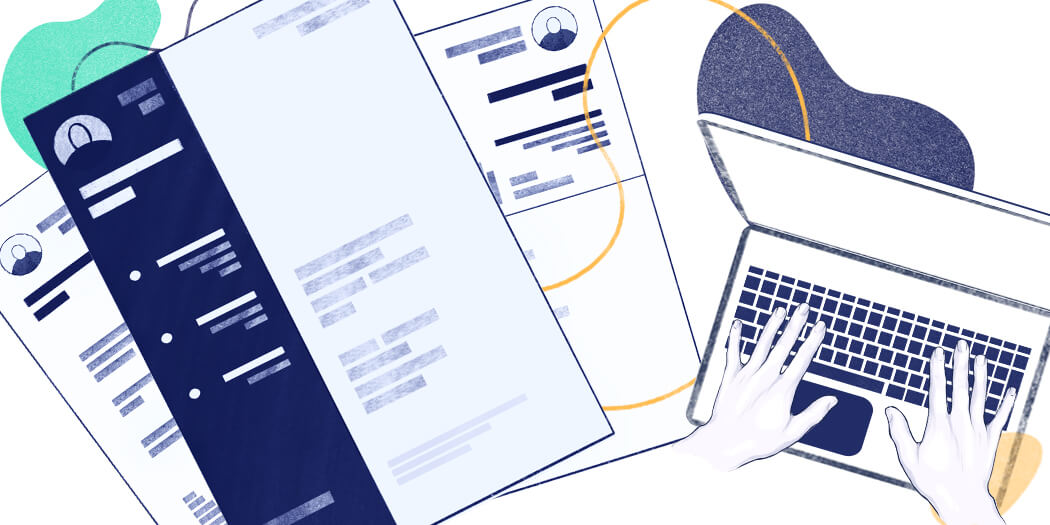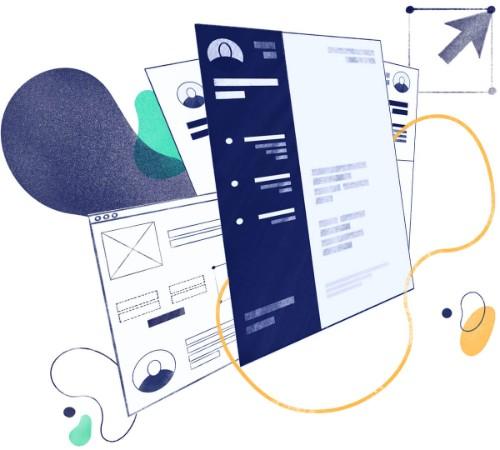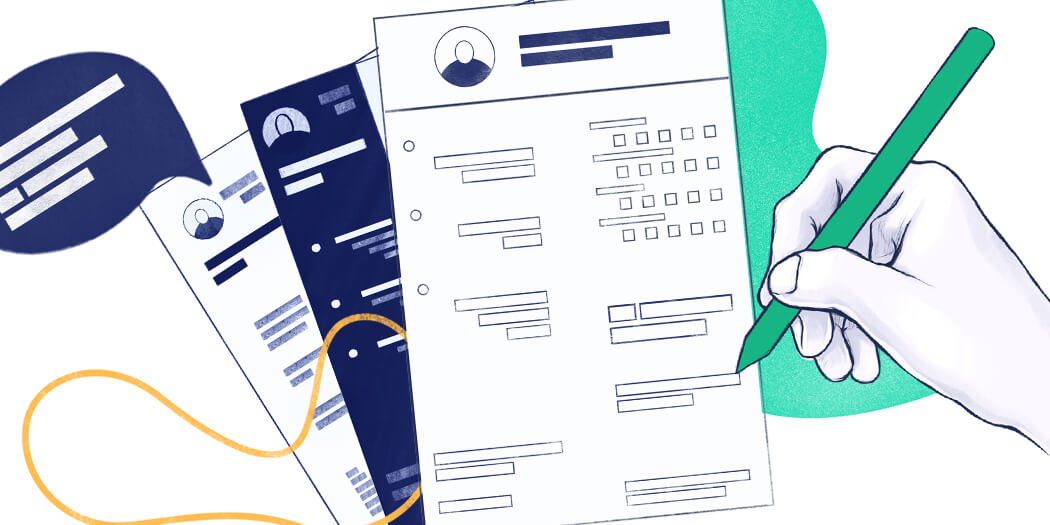
25+ Word Resume Templates (Free & Premium)
Thought that creating a resume in Word format is passé? Not if you use one of the top Word resume templates. See the best free and premium Word resumes.

Mariusz Wawrzyniak
Career Expert

Job hunting can be overwhelming by itself, and the sheer amount of resume formats and layouts isn’t helpful. Learn what the two most common resume styles are and when to use them.
Wouldn’t it be easier if there was only one type of resume that is universally accepted by employers? It would be, but it wouldn’t be any fun, right? The good news is:
It’s not that hard to figure out which type of resume to choose, and once you’ve made your pick, you can truly highlight your individual strengths, skills, and talents with the right formatting. So let’s dive right into it, and find out what the two most common resume styles are all about: functional vs chronological resumes.
In this article:
Save hours of work and get a job-winning resume like this. Try our resume builder with 20+ resume templates and create your resume now.

What users say about ResumeLab:
I had an interview yesterday and the first thing they said on the phone was: “Wow! I love your resume.”
Patrick
I love the variety of templates. Good job guys, keep up the good work!
Dylan
My previous resume was really weak and I used to spend hours adjusting it in Word. Now, I can introduce any changes within minutes. Absolutely wonderful!
George
Looking for a specific type of resume? See these:
A functional resume focuses on the skills you’ve gained throughout your career, with less importance given to your exact work history.
A chronological resume, meanwhile, places emphasis on your work history, as it lists every relevant job you’ve held in reverse-chronological order (most recent first).
A resume is the first step towards getting an interview and your one-way ticket into your dream job. How you sell yourself on a resume is crucial to the impression you make on the hiring manager and your future employers.
Picking the best resume style to put the spotlight on your biggest strengths is important in positioning yourself as the ideal candidate for that next great job. Plus, sticking to an accepted resume format will help you organize your information on the page in a logical manner, which goes a long way towards boosting readability.
Now then—Let’s take a look at an example for each resume type: functional and chronological. See which one would work best for you!
Let’s begin:
A chronological resume is the most common resume format that shows your work experience and education in reverse chronological order, where your most recent jobs are at the top and your least recent jobs are down below.
As you’ll see in the example below, a chronological resume focuses primarily on employment history. Let's take a closer look at the chronological resume to see if this is resume style is right for you:
Amanda Hinkle
Human Resources Specialist
909-209-7674
a.hinkle92@gmail.com
Summary
Personable and dedicated HR Specialist with 7+ years of experience maintaining a staff of 100+ employees. Advised and influenced employee management and leadership with a focus on performance, organizational development and effectiveness. Seeking to join Stexoa as Human Resources Manager.
Experience
Human Resources Specialist
ChactFox, Inc., Philadelphia, PA
May 2018–Dec 2021
Human Resources Administrative Assistant
Bea Wire, Little Rock, AR
June 2014–May 2018
Education
BA in Business Administration
Arkansas State University
2015
Certifications
PHR Certified
2015
Imagine bumping into an old friend from high school you haven't seen since 2011. What’s the first question you ask them? “Hey, what were you doing in 2012?”
Hell no. First, you’ll probably want to know what’ve they been up to lately… Right? Same with a recruiter.
They’ll be definitely more interested in what you've been doing professionally recently, not what you did at an internship right out of college a decade ago.
And that's why a chronological resume will work best for most career situations. So to sum up, the advantages of a chronological resume are:
Here’s a quick run-through of how to write a resume:
Right below your resume header, you should write a short, yet compelling resume summary or objective, which summarizes your skills, experience and qualifications.
If you’re writing an entry-level resume, your objective statement should explain why you are interested in the job and why you are fit for it.
The next part of your resume should be a detailed description of your work history, listed in reverse chronological order. That means listing your entries by starting with the most recent one.
Remember to use special keywords that will ensure you're actually submitting a true ATS resume.
Expert Hint: The chronological resume layout is more ATS-friendly, which is important to note since most businesses (including the majority of Fortune 500 companies) use an Applicant Tracking System to perform the initial scan of the submitted resumes.
Listing your education on your resume can set you apart from hundreds of other candidates and it’s easy to make it look neat and professional. The important thing to remember is to list your entries in the same order you listed your previous jobs.
But don’t list everything. For example, if you have a BA and are currently working on a Master’s degree, you can include two entries, but for most cases, putting your most recent degree should be enough.
Just below your education, you should include a separate resume skills section that gives a general overview of your hard and soft skills.
Don’t go into too much detail. Simply listing your skills in bullet points should do the trick. You can, however, make two lists, one for your soft skills (like communication skills, management skills, leadership skills, etc.), and the other for hard skills (technical, computer skills, etc.)
Let’s raise your resume up a notch. If you have something else you’d like to show off on your resume, feel free to include any relevant information that you think will increase your chances of getting that interview:
And that’s all there is to it! Now that you know what a chronological resume looks like, let’s move on to the second part of the guide…
Next up: Functional resume.
The ResumeLab builder is more than looks. Get specific content to boost your chances of getting the job. Add job descriptions, bullet points, and skills. Easy. Improve your resume in our resume builder now.

Nail it all with a splash of color, choose a clean font, and highlight your skills in just a few clicks. You're the perfect candidate, and we'll prove it. Use our resume builder now.
As you can see from the example below, in a functional resume, the main focus is on your skills rather than your work experience. It’s a good idea to choose this resume layout when you have little work experience or want to start a career in a new industry—
This format can help you disguise lack of experience or any employment gaps.
Lauren Donovan
Executive Chef
2606 Pinewood Drive
Arlington Heights, IL 60005
847-801-6707
lauren.donovan@gmail.com
Summary
Award-winning Executive Chef with 9+ years of culinary experience. Managed a high-volume kitchen of 35 staff members for a restaurant with annual sales of $1.5M. Managed all kitchen operations in an upscale restaurant, serving some of the best-quality Greek seafood in town for more than 300 guests a day. Seeking to fill the Chef de Cuisine position at Le Fou Frog.
Core Skills
Creativity
Leadership Skills
Business Sense
Work History
Executive Chef
Ephesus Restaurant, Chicago, IL
2015-2021
Sous Chef
Lazy Bear, Chicago, IL
2009-2013
Education
Culinary Arts Program
Institute of Culinary Education
New York, NY
2011
Languages
French—proficient
Many jobseekers wonder how to write a resume if they don’t have a clear employment history, or if they’re writing a resume for a career change.
They might think that they don’t stand a chance against other, more experienced candidates. Fortunately, there is a solution!
A functional resume is perfect for downplaying any gaps in your work history or for people who want to switch industries, since the section featuring skills for a resume is its main focus.
When to use a functional resume?
When writing a functional resume, use this short checklist to make sure you have all the resume sections in place:
Start with a professional profile that talks about your qualifications and career goals. Let’s see a couple of examples to get a better understanding of what a correct resume summary should look like:
Summary
Award-winning Executive Chef with 9+ years of culinary experience. Managed a high-volume kitchen of 35 staff members for a restaurant with annual sales of $1.5M. Managed all kitchen operations in an upscale restaurant, serving some of the best-quality Greek seafood in town for more than 300 guests a day. Seeking to fill the Chef de Cuisine position at Le Fou Frog.
The first example has the “WOW” effect, and while the second one isn't terrible, this candidate failed to provide any proof of their skills.
Make sure to elaborate on each skill that you think is important for the role. Use phrases from the job advertisement to ensure your resume is targeted to the specific job.
Core Skills
Creativity
Leadership Skills
Business Sense
This example clearly demonstrates the candidate’s most important strengths and elaborates on them.
…without expanding it into duties and responsibilities. This is just to show that you have worked for reputable employers and gained a substantial amount of experience from the opportunities.
Work History
Executive Chef
Ephesus Restaurant, Chicago, IL
2015–2021
Sous Chef
Lazy Bear, Chicago, IL
2009–2013
Now, by looking at this example alone, we notice that this specific candidate has a two-year employment gap, but with a polished and detailed skills section like the one above, the recruiter might not even notice it.
Education is always considered as advantage in the employment market, so make sure to mention it in your functional resume.
Education
Culinary Arts Program
Institute of Culinary Education
New York, NY
2011
Expert Hint: If there’s anything else that you’d like to share regarding your education, feel free to include it: your GPA, relevant coursework, extracurricular activities, etc.
Just like with a chronological resume, extra sections (Volunteering, Languages, Certifications, etc.) can help to show the recruiters that you are the right person for the position.
Languages
Certifications
Other Activities
While it’s great to have other hobbies outside of work, leave out any information that isn’t relevant to the position you’re applying for.
Now do you know which resume style to choose?
Double your impact with a matching resume and cover letter combo. Use our cover letter generator and make your application documents pop out.

Want to try a different look? There's 21 more. A single click will give your document a total makeover. Pick a cover letter template here.
Let’s wrap it up—
Thanks for reading! Got any lingering questions about using a chronological vs functional resume? Perhaps you have some experience in this matter that you’d like to share? Give us a shout in the comments!
At ResumeLab, quality is at the crux of our values, supporting our commitment to delivering top-notch career resources. The editorial team of career experts carefully reviews every article in accordance with editorial guidelines, ensuring the high quality and reliability of our content. We actively conduct original research, shedding light on the job market's intricacies and earning recognition from numerous influential news outlets. Our dedication to delivering expert career advice attracts millions of readers to our blog each year.

Thought that creating a resume in Word format is passé? Not if you use one of the top Word resume templates. See the best free and premium Word resumes.

Mariusz Wawrzyniak
Career Expert

Explore my top picks from the Google Docs resume template collection and learn how to craft your own standout resume. Use a Google Doc resume that reflects your style.

Mariusz Wawrzyniak
Career Expert

Do people lie on their resumes? We asked over 1,000 Americans if they stretched the truth of their employment history and other sections on their resume. See what we discovered.

Bart Turczynski
Career Expert